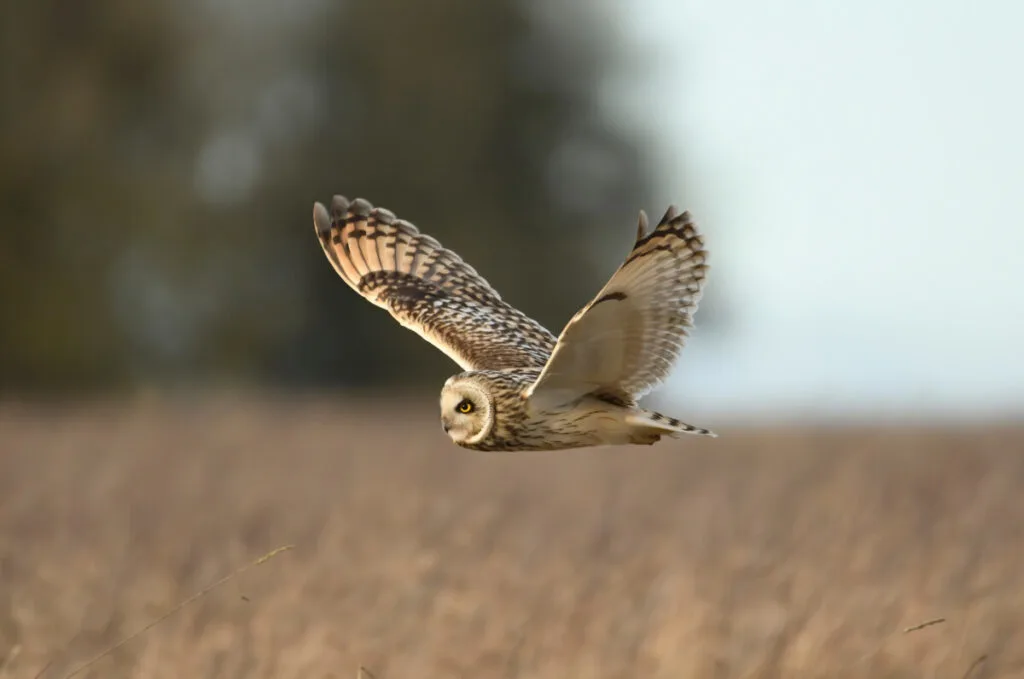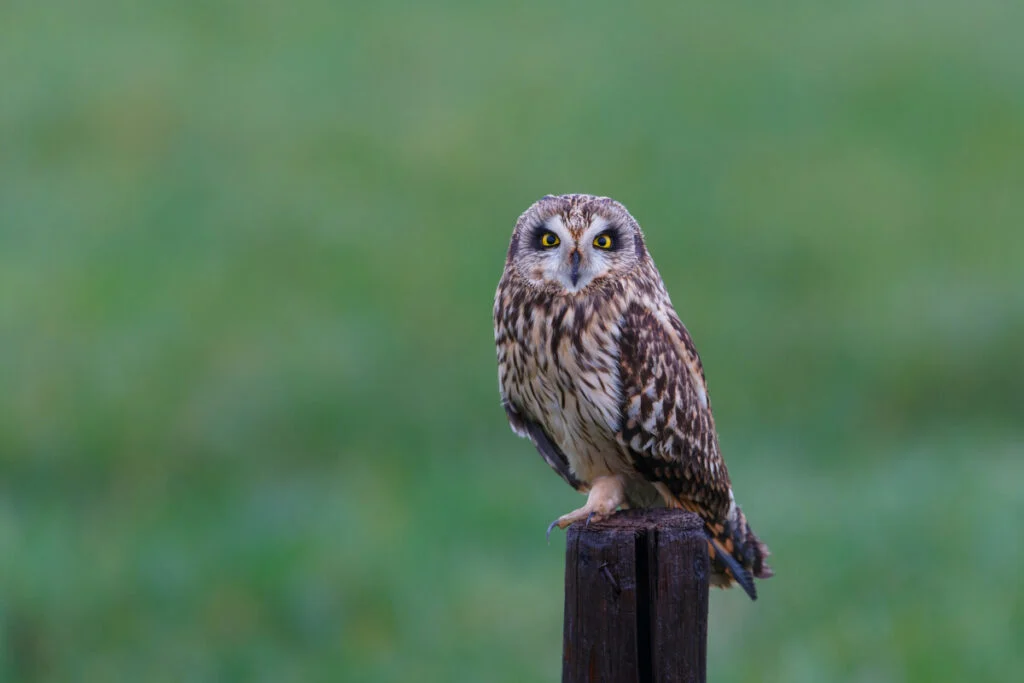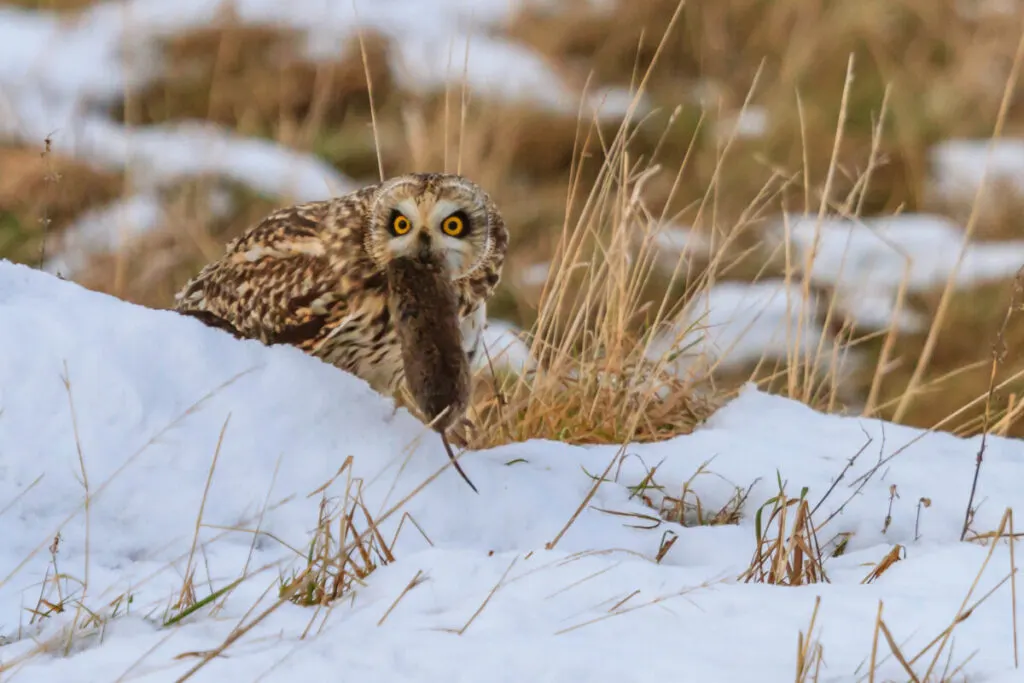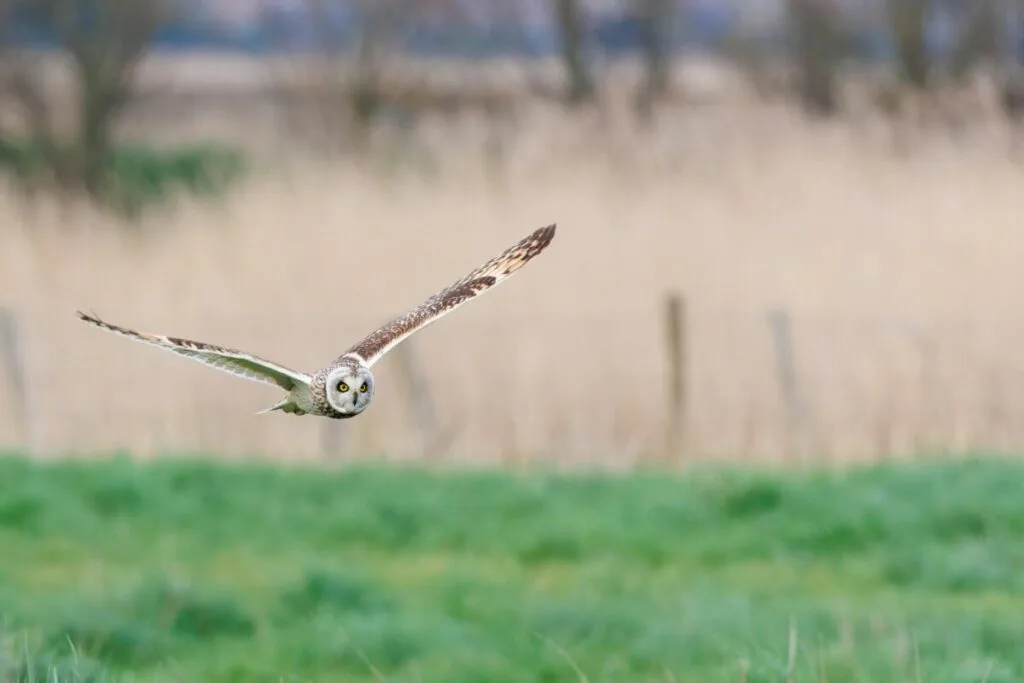The Short-Eared Owl, scientifically known as Asio flammeus, is a captivating bird species that belongs to the Strigidae family under the Strigiformes order. This species is known for its distinctive features and behaviors, making it a fascinating subject for bird enthusiasts and conservationists. But the question that lingers in the minds of many is, “Is this species endangered?”
What Is the Short-Eared Owl?

The Short-eared owl, known scientifically as Asio flammeus, is a medium-sized owl species in the Strigidae family. These small mammals are unique due to their diurnal nature, which is active during the day, unlike most owls. It is named for its short ear tufts, feathers resembling mammalian ears, often difficult to see as they blend in with the bird’s feathers decorating their broad wings.
It is known for its bright yellow eyes, encircled by dark patches, giving it an intense gaze, in addition to the very short tufts on either side of its head. Its body is covered in brown and white mottled tawny feathers, which provide excellent camouflage against tree bark and grasslands. The wings are long and rounded, perfect for its low, gliding flight pattern when hunting.
Besides the small ear tufts, this native owl has a distinctive, scratchy, bark-like call. You’ll typically see a barred tail, dark markings, a short neck, and black rings encircling their yellow-orange eyes.
This species is in North and South America, Europe, Asia, and the Hawaiian Islands. Despite its broad range, these widely distributed owls face significant threats, leading to its inclusion on the Red List of endangered species.
Habitat

The Short-Eared Owl is a versatile bird when it comes to its habitat. It can be found in various environments, including grasslands, marshes, agricultural fields, tundra, and open woodland areas. This owl prefers open areas where it can use its keen eyesight and hearing to locate prey.
One of the notable habitats is the Wadden area, specifically the island of Texel. This region provides an ideal environment for them to nest in, with an abundance of its primary food source, the Northern Vole. The dunes near Den Hoorn are particularly favored by this species for breeding.
It is a ground-nesting bird, which is unusual among owl species. You’ll find short-eared owl nests in tall grass or on the ground, often at the base of a tree or bush. This ground-nesting behavior makes the species vulnerable to predation and human disturbance threats.
Conservation efforts are ongoing to protect the habitats, particularly in coastal grasslands, where you’d find their breeding grounds. These efforts include habitat management to maintain open, grassy areas for nesting and hunting, as well as public education to minimize human disturbance to these sensitive birds.
The Short-Eared Owl, or ‘Sumpfohreule’ as it is known in some regions, is a sight to behold. Its hunting prowess is a spectacle that leaves observers in awe. With its graceful wings, the owl flies low over fields until it swoops down on its prey, feet first. It relies on its sharp eyesight and acute hearing to locate its preferred prey, the meadow voles, which are abundant on the island of Texel.
See Related: Forest Owlet: Why is it critically endangered?
Short-Eared Owls’ Breeding Season

Texel, a Wadden island, is a veritable bird paradise. Despite the rarity of Short-Eared Owls, the chances of spotting this owl on Texel are higher than other owls.
This is because it is active during the day. When not hunting, it sits quietly on the ground, blending in with its surroundings as long as there is sufficient ground cover. They work to conceal nests in grass stems.
Short-eared owls are rare breeding birds of the dunes, especially near Den Hoorn. In autumn and winter, groups of Short-Eared Owls can sometimes be seen on Texel, often along the Wadden dike. Their breeding habitat is on the ground. When it gets colder, they make communal winter roosts.
During the breeding season in spring and before the autumn migration, birds come to rest and refuel in Wadden. They begin to pair off during February, when you’ll likely see a male bringing food or performing wing clapping (making exaggerated wing beats) to attract females. Breeding occurs during June. Consisting of four to seven eggs, large clutches laid near the end of June tend to do the best.
Short-Eared Owl vs. Northern Harrier

Short-eared owls hunt in grass and open areas, hovering close to the ground as they watch for prey. Their population is closely linked to the density of voles and other small mammals.
Like other bird species that rely on fluctuating food resources, such as Snowbirds, Short-eared Owls show significant local variation in their numbers and reproductive rates. Short-eared Owls and Northern Harriers often hunt together for deer mice or ground squirrels, occasionally harassing each other when their night and day shifts overlap. Harriers have been known to steal food from owls.
See Related: Congo Peafowl: Is This Animal Endangered?
Population Threats

These owls, while not currently classified as threatened, find themselves in a vulnerable position due to the destructive implications of habitat destruction. The owl can be seen throughout the year.
Unfortunately, it is also on the Red List, indicating that it is a species at risk. Bird Protection Netherlands and other conservation organizations work tirelessly to protect this species and its habitat.
Habitat Destruction
The encroachment of agricultural activities, farming practices, and urban development causes this unfortunate circumstance. As these habitats are altered or destroyed, it becomes increasingly challenging for the short-eared owls to thrive and find suitable environments for hunting and nesting.
Human Activities
Tragically, these majestic birds frequently meet their untimely demise through accidental collisions with airport vehicles or airplanes. The vast open spaces and potential confusion between the birds and aircraft can devastate both parties.
Furthermore, short-eared owls often face additional hardships, such as persecution from humans who view them as nuisances or threats to livestock or poultry. Poisoning is another grim fate that awaits these beautiful creatures, as some individuals resort to harmful methods to control populations or protect their interests.
To make matters worse, predation adds yet another layer of danger. Natural predators, such as larger birds of prey or mammalian predators, constantly threaten their survival.
This unrelenting pressure from various sources compounds the challenges these vulnerable creatures face. We must strive towards conservation efforts that protect these magnificent birds and ensure their continued existence.
See Related: Mexican Spotted Owl: Why Is It Endangered?
FAQs
Where do short-eared owls live?
Prairies, marshes, dunes, and tundras. This type of open country hosts a large number of small rodent species meaning there is a high food abundance.
The most common nesting areas are tundras, marshlands, and farmlands. These species can be found in grasslands, sand fields, small meadows, coastal dunes, shrubs, and sandy areas during winter.
Where are short-eared owls located?
Short-eared owls, which can be found in numerous countries around the world, can embark on extended journeys. Particularly in the northern populations, these birds are known for their migratory habits or nomadic lifestyles.
Do short-eared owls nest on the ground?
Short-eared owls nest in grassy areas under dense forests or low trees. A grass mound works best. They prefer dry places, often on rocky or ridged terrain, with plenty of low vegetation for protection.
Related Resources
- Philippine Eagle: Species Overview, Conservation and Threats
- Andean Flamingo: Why is it Endangered?
- Whooping Crane: Why Is It Endangered?


